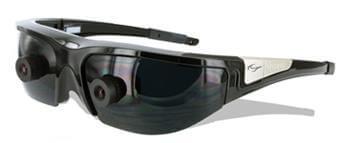
You may think the ability to reshape your world as you see fit would be priceless, but it’s not. Vuzix will sell it to you for $2000. Their Wrap920AR glasses allow users to combine digital images with the video feed taken by two cameras mounted on the front of the lenses. The integrated video is then shown to the wearer via two miniature screens embedded in the glasses. Slightly varied images in the right and left eye give the video a sense of depth, while head tracking sensors allow users to look at different sides of a virtual object. Augmented reality goggles like these are usually only found in academic research labs or as high-end concept pieces from tech companies that may cost many thousands of dollars. Vuzix is making these glasses widely available, and for relatively cheap. They’ve given a few people a chance to thoroughly test the Wrap920AR and share what the users sees in various augmented reality setups. Watch the video from ShinyMedia below. I’ve seen this footage dozens of times and my jaw is still on the floor.
When I saw the Wrap920AR in person at CES 2010 it was playing a very simple maze game. The 3D effect was cool, but sort of hurt your eyes. The demonstration in the video above is light-years ahead of the one in January. We’ve seen augmented reality of this caliber before, but rarely in 3D, and never on a glasses platform. I’m a little upset that the Wrap920AR costs $2000 (reps at CES originally told me it would be closer to $800) and I don’t think home users will plunk down two grand for a personal AR system no matter how cool it is. That being said, there’s a lot of potential here for engineers to leap into AR development using the Wrap920AR as a relatively inexpensive platform. Others have already done that with Vuzix’s cheaper iWear model (without 3D). Once we figure out how to make AR systems like the Wrap920AR for $500 and with a long battery life, they could replace the screens on smart phones – maybe even replace the entire phone. It’s going to be an amazing future when I can walk down the street with augmented directions guiding my steps, and AR data telling me about the shops and restaurants around me. Watching virtual dragons fly around wouldn’t be too shabby either.

[image credits: Vuzix, Technology Review]
[video credit: ShinyMedia]
[source: Technology Review, Vuzix]


